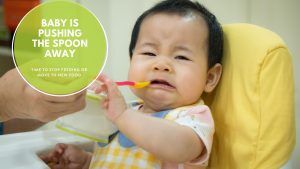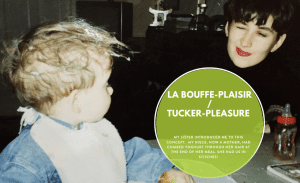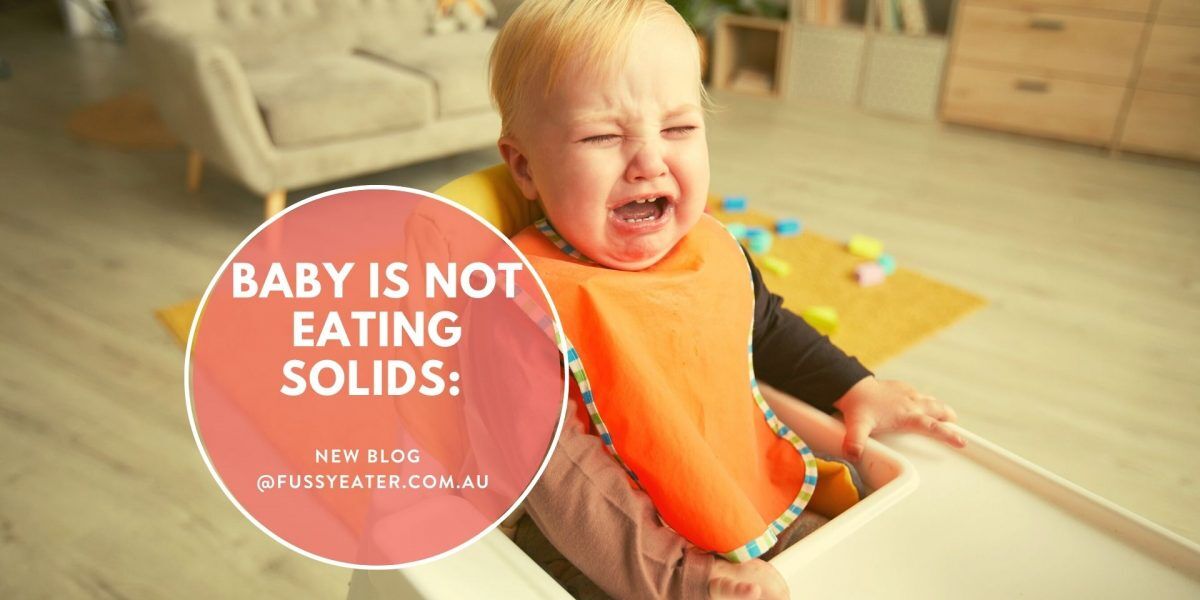
Baby is not eating solids and you are getting concerned. Initially, you were excited to introduce solids, however, Baby is showing little interest. Feeding challenges are quite common. Often, small adjustments will improve the situation. This post is about helping parents understand the reasons behind Baby’s food refusals. It gives tips on how to improve the situation and clarifies when to seek professional help. Feeding difficulties may compound over the years. Early intervention based on the principles of Responsive Feeding is a good idea.
Misconceptions about the place of solids
You may hear that “food under 1 year of age is for fun”. Perhaps it is not the best way to put it. Introducing solids has specific objectives. They suffer when feeding is problematic. Here’s why a successful introduction of solids matters:
-
nutrition, so babies get additional nutrients, find out more about these important nutrients here,
-
chewing skills. Children start developing chewing skills. First with foods that are pureed or squishy. By age 3 children have mature chewing,
-
allergy testing, food allergens are introduced before age 1,
-
transition to eating mostly solids by age 1,
-
Introduction of many different foods as possible before age 2 so children are comfortable with a wide range of foods.
Baby is not eating solids, is she ready?
Baby’s readiness matters. Starting solids when Baby is not ready may put both of you in early difficulties. The WHO recommends starting feeding solids when babies are around 6 months of age and show signs of readiness. GPs may advise some families to start solids around 4 months, particularly if there are allergies or coeliac antecedents in the family. Here I wrote about readiness in this kiddipedia article. What you are looking for is that Baby:
-
has reduced tongue thrust ,
-
follows food with her eyes, or reaches out for it.
-
sits upright with her head held steady, (before 6 months baby can sit slightly reclined to eat purees).
-
opens her mouth and closes it around the spoon.
If she is not quite ready, then it is best to wait, observe and reboot.
What to do about what you observe
Once Baby is ready, feeding can run smoothly and become enjoyable for all. However, some families are still struggling. It pays to observe what is happening to understand what to do next. So what are your observations about your baby’s feeding?
-
Was she struggling with breast or bottle feeding? Was her tongue checked? Was there discomfort? is there any pain with eating and /or swallowing? Sometimes mechanics or discomfort, for example due to reflux or allergies may get in the way,
-
shows no interest: is she not hungry? Parents may resort to feeding her almost constantly because they worry about her limited appetite or interest in eating. It is important to keep a routine so appetite may surface. From 9 months you can give solids a better chance by offering them first,
-
would rather drink milk: does she need comfort? Is she compensating with milk? A 11 months, babies may drink 2/3 bottles per day, then 1 or 2 bottles at age 1. Too much milk after 1 year of age may increase constipation, impact iron levels and reduce interest in solids. You can see it’s a catch 22 of managing appetite and the place of solids and milk,
-
spits out most of the food: is the food soft enough, are the texture and size manageable? Baby is learning to manage food. She has to chew, form a bolus and swallow: this is quite a task. Some foods require more work and it is OK for baby to spit them out until she can manage them better. From a sensory perspective, she may need more time to learn to deal with the texture, the taste or even the smell of the food. That’s OK. As Baby spits out she is showing her capacity to “work it out”. This does not indicate that she does not like the food. Offer this food regularly,
-
struggles with lumpy textures: many babies struggle to manage lumpy purees. These babies will usually do better when self-feeding (BLW). They can still become familiar with lumpy textured food if it is served on a loaded spoon set to the side of their normal meal.
-
gets distracted/throws the spoon away, or food on the ground: has Baby had enough to eat, was she hungry coming to the table? It is best to take cues and move on after a little while,
-
gags: gagging is part of the normal process of learning to eat. Babies gag to protect their airways from food they have not reduced to a size small enough (hence the need for squishy or pureed first foods). When Baby is gagging it is important to stay composed. Frequent gagging, a strong gag reflex may require further investigation by a Speech Language Pathologist (SLP),
-
gagging is not choking. Choking incidents need to be investigated with GP/SLP. Fear and trauma may occur as a result.
-
is upset or seems uncomfortable: It pays to address the causes. Does Baby have a dirty nappy? Is she teething, or unwell,
-
drools profusely: if drooling occurs away from teething, it may be worth checking with an SLP,
-
does not touch new food: Baby will need more exposure, the goal here is for her to be comfortable with the food nearby. It is ideal if you model eating this new food.
-
won’t be fed: some babies show their capacity and desire to be autonomous. It is best to have 2 or 3 spoons, load them and let Baby do the rest,
-
refuses the spoon: is Baby’s experience with the spoon unpleasant? Is the food shoved into Baby’s mouth without her permission? Is it forced in? Is the food deposited in the mouth and the spoon pulled out, before Baby clears it? Is the spoon used to scrape off food? Baby may make negative associations with feeding. It may help to do BLW for a while. Parents can introduce spoons again after enough time has passed. Babies will first help themselves from loaded spoons. You may then work on spoon-feeding: make eye contact, offer verbally, show the spoon first so Baby can see what is on it. We are looking for Baby to tilt her head forward, close her lips on the spoon and remove the food by herself,
-
struggles with the food choice, the smell, the texture and gets quite distressed. Eating engages all our senses. Some babies are more sensitive and may need more time to process what is in front of them from a sensory perspective. It is best to remove any pressure yet offer the ‘offensive food’ regularly. For example, Baby is not keen to eat pureed pumpkin. Parents can still offer it once a week/fortnight, and also offer well-cooked cubed pumpkin once a week/fortnight. Parents can serve pumpkin with 2 or 3 other foods. It is best not to overwhelm Baby with huge portions. Again a shared plate with whoever feeds may be helpful. Parents’ win at this stage is to witness a happy, relaxed Baby at the table,
-
appetite is irregular. It is widely accepted that babies can regulate their food intake[1]. Some babies will eat tiny amounts at some meals and much better at others. Some babies may show small appetites overall, but if they grow with regularity, then there is less cause for concern.

Adaptations you may be tempted to make
It usually tells me you are struggling when you make “adaptations” to feeding. While this may reduce your stress or anxiety a tad, it may create more difficulties long term. Difficulties may compound over the years.
-
Pushing Baby to eat is stressful for them and eventually for you. It affects trust and engagement in feeding,
-
Distracting, for example, parents use a screen to distract baby. I wrote this about this video, where I see Benjamin, a toddler who struggles with eating. The video seems fun. However, as we take a step back, we see Dad’s objective is to distract Benjamin in order to get food into Benjamin’s mouth. While I have no doubt Benjamin’s Father wants the best outcome for his son, it is clear to me there are underlying feeding problems. As a result Benjamin may struggle for years with feeding, and so will the family,
-
Offering only food Baby will eat may work for a while, but babies can get bored. Once they drop the food they loved so much, everyone is even more stuck,
-
Feeding only commercial Baby food. These foods are so predictable when it comes to taste and texture that Baby may find it hard to accept anything else. Seasonal fruit and vegetables, home cooking provide variations that can help extend baby’s comfort zone,
-
Using only pouches may help baby consume a good volume, but baby may struggle to extend her range. The pouch also avoids much sensory input, as Baby does not interact with its content through her eyes and hands,
-
Feeding more often, feeding more milk, feeding everywhere reduces appetite at mealtimes. It is best to feed at the table and have a routine,
-
Misreading babies’ reaction to a particular food and ruling it out further limits Baby’s range. Keep offering the food regularly.

Spoon Feeding or Baby Led Weaning (BLW)?
Personally, I like a mix of both. Babies do well to learn to manage a wide range of textures, including lumps. They also do well when allowed to develop their self-feeding skills. It comes down to personal choice and feeding responsively.
Why it is important to model
I always recommend parents model eating in a pleasant, pressure-free manner. Parents may need to check what this looks like: do they look relaxed? Do they convey confidence? Babies love to watch their parents eat. Place yourself facing your child, share food as much as possible, relax and smile. Show what is in your mouth, even if it feels gross, your Baby is likely to enjoy the show. Babies take cues on how to tackle food from their parents.
Responsive feeding
Responsive feeding is very much about the relationship between Baby and the person who feeds her. Here you can read more about the Division Of Responsibility which is essential to responsive feeding.
Parents who feed responsively are aware of babies’ cues. Responsive feeding has structure. It has the when and where of feeding. It is pressure free. It is about building trust between Baby and parent. It requires permission from Baby, she will show her engagement by tilting her head forward when eating from a spoon.

Parent trust that Baby can:
-
eat enough,
-
learn the skills she needs,
-
become autonomous,
-
use her internal drive to manage appetite and learn about new foods.
Baby trusts that parent can:
-
Read cues for hunger, satiety, fatigue, discomfort, distress,
-
Make her comfortable,
-
Facilitate feeding by cutting food to size, cooking food as much as needed, charging spoons etc,
-
Offer variety and exposure to a wide range of foods,
-
Avoid pressure and be patient,
-
Demonstrate how and what to eat,
-
Be OK with some degree of mess and waste,
-
Avoid being harsh with spoons (no pushing/no scraping with metal spoons/or on irritated skin or cleaning (best done away from the table).
When to seek professional help
Many families I speak to know they need help because feeding is not fun, nor enjoyable for anyone. I support families with babies as young as 9 months when food refusal is a concern. Your GP or paediatrician is the main port of call. A Speech-Language Pathologist (SLP) can best assess oral motor skills and check for any swallowing issues. As you observe your Baby, it makes sense to seek help especially if Baby shows:
-
a lack of appetite and lethargy,
-
frequent food refusal,
-
frequent constipation,
-
persistent diarrhoea,
-
abdominal pain,
-
blood in stools,
-
lack of weight gain, (measurements are best taken regularly using the same professional scale), otherwise results may not be accurate,
-
pain when eating, swallowing,
-
vomit or reflux,
-
frequent arching or crying when feeding,
-
reaction to a food,
-
poor hydration (dehydration requires going to hospital emergencies),
-
frequent gagging. When it occurs before Baby places food in her mouth, it may warrant further investigation. A difficulty with textures (lumps, bits that require chewing) or a sensitivity to smells for example, are worth discussing,
-
food allergies or intolerance.
Feeding babies and children can be extremely challenging, I hear you. Hopefully, you now feel that you have sufficient information to get you started on your journey of responsive feeding. If necessary you can reset feeding your Baby or get adequate support.
Remember you can always have a chat with me if you are unsure what type of support may help you.



